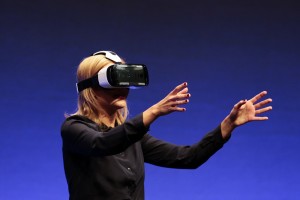By Andrew Street
Blogger
If you’ve been following the video game industry even slightly over the last two years, you’ve definitely noticed the growing push for virtual reality. Major players like Oculus, Valve and Sony are aiming to innovate and pave the way for a new video game experience with their own VR headsets. As we near the commercial release of these finalized products, it begs the question: is VR the next step for video games as a medium, or is it the second coming gimmick of motion controls?

Many people have compared this mass push for VR to be similar to the implementation of motion controls during the last console cycle. Following the release, and commercial success of Nintendo’s Wii, other console creators looked to garner the same prosperity. However, neither PlayStation nor Xbox managed to gain the results Nintendo had. The two companies’ products sold fairly well—the Kinect broke records for the fastest piece of technology—but they delivered little substance in terms of memorable gameplay. Instead, we saw motion awkwardly implemented in AAA games and other titles aimed at more casual audiences. For months, many tech aficionados claimed that motion-based gaming would be the future, but with the exception of Nintendo, the trend fell off relatively fast.
You could reasonably assume that virtual reality is going to go the way of motion-based gaming, especially considering the similarities. Like the Kinect or PS Move, VR headsets would be separately purchased devices. As it typically goes with those, developers won’t get behind them unless there is a large install base or potential for new ideas. There is also the possibility for gimmicky, cheap, or rushed VR games, similar to what happened with motion controls that could create a negative stigma around the new platforms.
However, most of what we have seen points to VR being a bit different then motion controls. For starters, there are more players this time around. Valve, Sony, Oculus, Samsung and HTC are all working towards making virtual reality plausible. As a result, we are seeing different takes on headsets, controls, and even platforms which range from Smartphones and Consoles, to high-end PC’s. Each company is experimenting, and by the accounts of people using the products, doing very well.
When these headsets release in 2016, it will be crucial that they carry a catalog of appealing games that are easily accessible to the mainstream audience. Sony, whose headset has the largest potential for reaching the mainstream due to the PS4, seems to be learning from their past mistakes. There are currently over 200 developers creating games for their PlayStation VR headset. That shines in comparison to the 36 developers that were working on Move games prior to release. Likewise, Oculus Rift has hundreds of developers backing their headset.
The games and experiences will make or break the potential for VR, and these companies know that. Every major gaming conference we are seeing bigger titles coming to the platforms. Games like Rigs, Gran Turismo, and Elite Dangerous have captivated audiences and built excitement for the large scale potential of virtual reality. Just the same, technical demos like The London Heist have left critics impressed.
It’s easy to dismiss the increasing focus on virtual reality as another fad that will come and go, but there is too much potential to ignore. Everyone from indie developers to large publishers and massive companies are getting behind virtual reality. They are seemingly avoiding the mishaps that surrounded cheap motion control cash-ins. Instead we are seeing the beginning of what looks to be a new, and prosperous, way to enjoy video games. It certainly could be the dawn of the next PlayStation Move, but the future looks bright and overflowing with great games.




